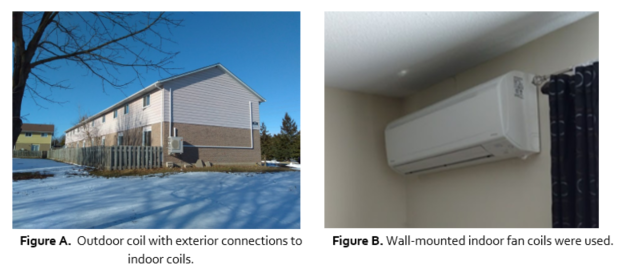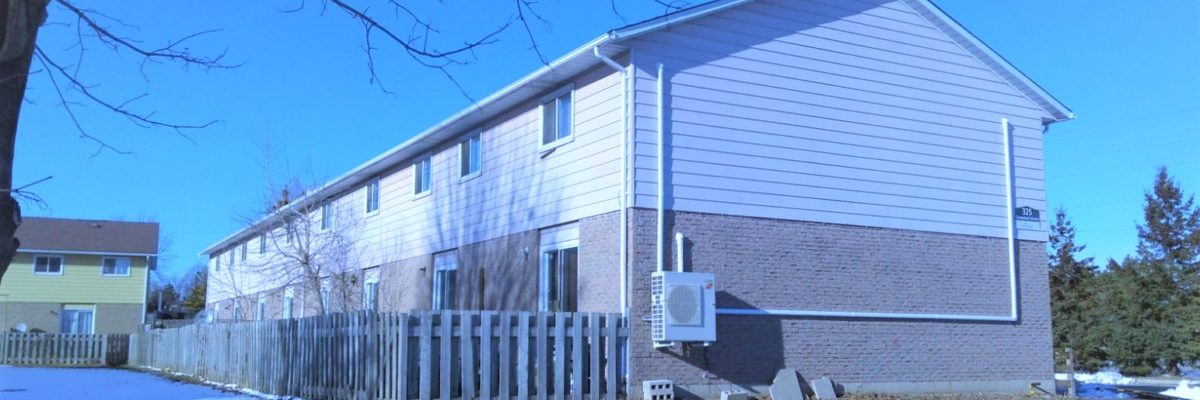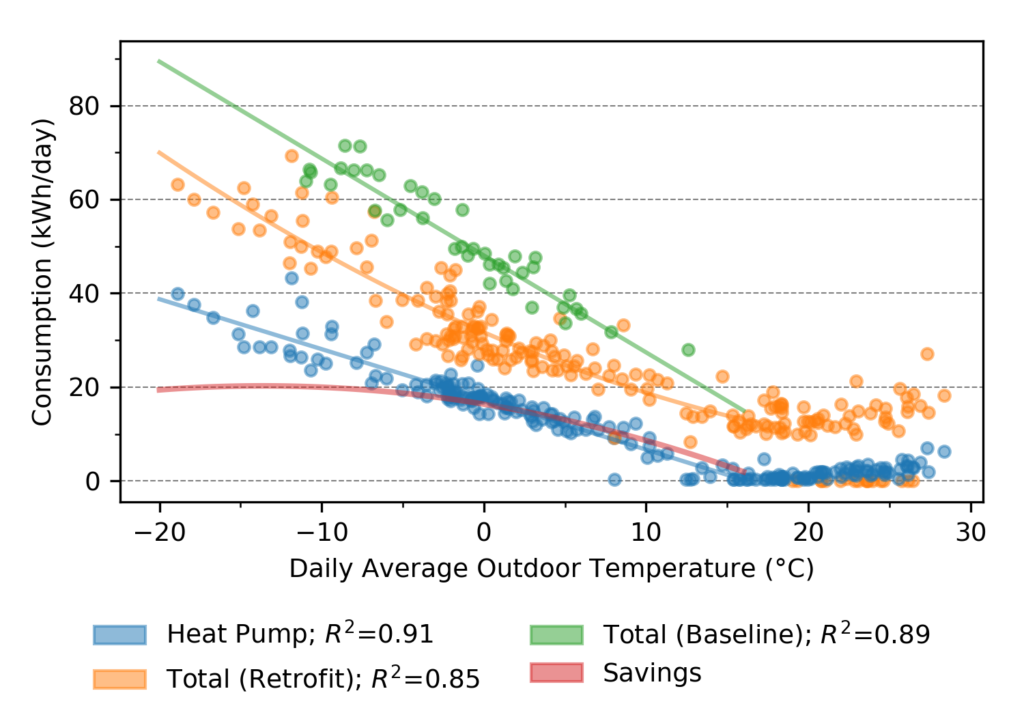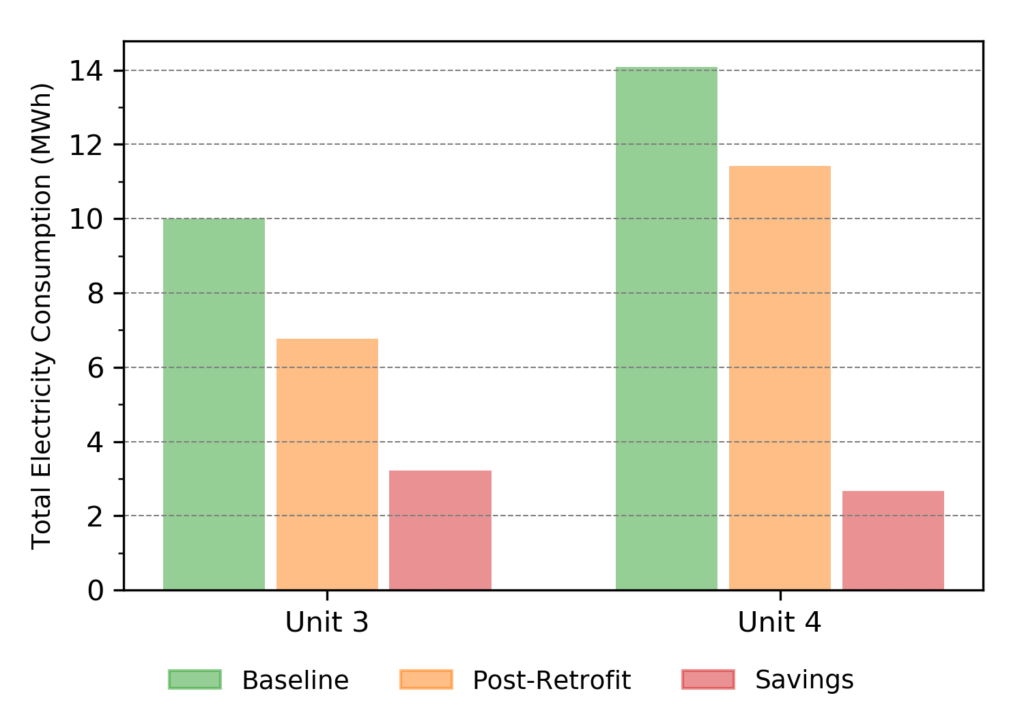Guest blog by Erik Janssen, Analyst, at Sustainable Technologies Evaluation Program (STEP), Toronto and Region Conservation Authority (TRCA)
We have just wrapped up one of several research projects co-funded by TAF and we’re here as a guest on TAF’s blog to share some results. Within this project, we determined the energy savings of real-world heat pump retrofits in an electrically heated rowhouse complex; but before getting to the findings, let’s start with the background.
More energy-efficient systems are needed
TAF estimated that electric baseboards are the main heating source for 24% of Ontario multi-unit residential (MURB) units. This is a problem. Baseboards are energy intensive, costly to operate, have increased carbon emissions compared to higher-efficiency alternatives, and occupy grid capacity that could be used for the electrification of other sectors.
A secondary issue is that electrically heated MURBs typically don’t have cooling systems or may rely on inefficient window air-conditioners. In the context of climate change, cooling systems will become increasingly important for health and safety. Energy-efficient heating and cooling systems are therefore needed for many reasons, and heat pump technology provides a solution.
The basic function of a heat pump is to absorb heat energy from one place and reject it to another. A refrigerator is a familiar example. It absorbs heat energy from inside the fridge (keeping it cool) and rejects it to the room (this heats the room). A heat pump is similar but it absorbs heat energy from the outdoor air or ground and rejects it into a building. The thing to note is that the process of absorbing and rejecting heat actually consumes less electricity than baseboard heating.
Heat pumps have been around for a long time and there are many types. However, despite recent advancements, they remain underutilized in Canada due to several barriers. An important (but surmountable) barrier is that there have been few case studies documenting actual energy savings in real buildings. STEP has the expertise to fill that knowledge gap and we wanted to help.
We reached out to primary project funders TAF and the Bloom Centre for Sustainability (a funding disbursement agency of the Ontario government) and gathered a team of other project partners and stakeholders, including Cricket Energy, Jama Property Management, Mitsubishi, Daikin, The Ontario Climate Consortium (OCC) and The Sustainable Neighbourhood Retrofit Action Plan (SNAP). Additional base funding for STEP projects is also provided by the City of Toronto, Region of Peel, and York Region.
Heat pumps tested in Brantford reduced energy use
We retrofitted four different units within a Brantford rowhouse complex in November 2017. We selected multi-split ductless air-source heat pumps (referred to simplly as “multi-splits” from here on) as a good fit. Multi-splits have a single outdoor fan coil connected to multiple ductless indoor fan coils. Indoor coils were wall-mounted, although other options are available. The connections were run on the exterior of the building and through small building penetrations. They were easy to retrofit and required no interior finish work or ducting.

Our monitoring experts deployed a cloud-based wireless monitoring system that collected data for nearly a year. Energy savings was then determined by our Certified Measurement and Verification Professionals (CMVPs) using industry standard practices. We found that the total heating season energy bill would be reduced by 19% to 32% in a typical year due to the multi-splits.
In the cooling season, we found that the heat pumps consumed (a very impressive) ~5x less energy when compared to the window shakers used in one of the control rowhouse units, to provide roughly the same amount of cooling. The magnitude of this difference was a surprise to the whole team. We speculate that the difference can be partly explained by the much poorer efficiency and installation quality of the window shakers but a definitive answer will need to come from future studies.
Figure C. The green data points show the actual whole-house energy consumption from one of the units when using baseboards. The orange data points shows the whole-house consumption when using a heat pump.
Figure D. For two of the units, the data was sufficient to estimate total home energy consumption and savings for a typical heating season.
We estimated that the average annual electricity savings over the lifetime of the equipment would be greater than $850. However, higher upfront costs compared to business-as-usual meant that the simple payback for these retrofits was estimated to be on the same scale as the expected equipment lifetime (~15 years). Note that these results were dependent on the behaviour of the tenants themselves and other installation-specific details. It is feasible that savings in other units could be greater or lower.
Interviews with the tenants were very positive. They appreciated the lower energy bills, even heating, quiet operation, remote controls, easy operation and the addition of cooling to their units.
Heat pumps adoption can and should be boosted
So what did we learn?
- The heat pumps worked well and provided a high degree of thermal comfort
- They saved a notable amount of energy and reduced operating costs
- They were user-friendly and highly appreciated by tenants
- Upfront costs are a significant barrier but may be less of a barrier for other variants of the technology (like lower-cost “mini-splits” or large-scale VRF systems) and this needs to be further explored
Moving forward, more measurement and verification (M&V) is needed across different heat pump types to help build consensus on achievable real-world energy savings and increase the confidence of potential adopters. We see this project as a first step and appreciate that TAF took it with us!
For more information:
- Read the brief summary
- Read the full report
- Follow STEP on social media: Twitter and LinkedIn
- Connect with Erik directly via LinkedIn or email
—–
STEP is a collaborative non-profit research initiative within the TRCA. Among other priorities, STEP leverages partnerships with municipalities, provincial and federal government bodies, utilities, non-profits, academic institutions and private companies, to pilot and evaluate emerging low-carbon technologies with the aim of providing real-world data that informs effective technological responses to climate change. STEP team members are scientific monitoring and M & V experts, particularly as it pertains to renewable energy, HVAC and smart-grid. Our research projects are conducted either in one of our own state-of-the-art Living Labs or off-site in real-world buildings.
TAF provided multi-year funding to the TRCA in 2016 for this project.



